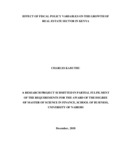| dc.contributor.author | Kabuthu, Charles | |
| dc.date.accessioned | 2019-01-15T12:15:57Z | |
| dc.date.available | 2019-01-15T12:15:57Z | |
| dc.date.issued | 2018 | |
| dc.identifier.uri | http://hdl.handle.net/11295/104763 | |
| dc.description.abstract | Kenya has experienced a big boom in the real estate sector in the recent past to be ranked the fourth highest contributor to the economy. This is as a direct response to increased demand. The Kenya population is fast growing coupled with an increase in rural-urban migration. The middle class with demand for housing in the city is fast rising. Kenya is putting in place fiscal policies to grow the real estate sector in the country as it is believed to be a key contributor to economic prosperity. This study explored the effect of fiscal policy variables on growth of real estate sector in Kenya. The population for the study was all the 80 real estate firms that form the real estate composite index. The independent variable was fiscal policy as measured by balance of payment, government expenditure, external government debt and taxation. The control variables were interest rate as measured by CBK quarterly lending rate, inflation rates as measured by quarterly CPI, unemployment as measured by unemployment rate and exchange rates as measured by quarterly exchange rate between ksh and usd. Growth of the real estate sector was the dependent variable which the study sought to explain and it was measured by quarterly percent growth in composite index. Secondary data was collected for a period of 10 years (January 2008 to December 2017) on a quarterly basis. The study employed a descriptive cross-sectional research design and a multiple linear regression model was used to analyze the relationship between the variables. Statistical package for social sciences version 21 was used for data analysis purposes. The results of the study produced R-square value of 0.813 which means that about 81.3 percent of the changes in growth of the real estate sector in Kenya can be explained by the four selected independent variables while 18.7 percent in the variation was associated with other factors not covered in this research. The study also found that the independent variables had a strong correlation with growth of the real estate sector (R=0.902). ANOVA results show that the F statistic was significant at 5% level with a p=0.000. Therefore the model was fit to explain growth of the real estate sector in Kenya. The results further revealed that individually only balance of payment and unemployment rate are statistically significant determinants of growth of real estate sector in Kenya. This study recommended that adequate measures should be put into place to improve and grow the real estate sector in Kenya by reducing both the prevailing unemployment rate levels and current account deficit. | en_US |
| dc.language.iso | en | en_US |
| dc.publisher | University of Nairobi | en_US |
| dc.rights | Attribution-NonCommercial-NoDerivs 3.0 United States | * |
| dc.rights.uri | http://creativecommons.org/licenses/by-nc-nd/3.0/us/ | * |
| dc.subject | Effect of Fiscal Policy Variables on the Growth of Real Estate Sector in Kenya | en_US |
| dc.title | Effect of Fiscal Policy Variables on the Growth of Real Estate Sector in Kenya | en_US |
| dc.type | Thesis | en_US |



